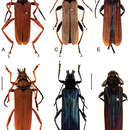Description
provided by Zookeys
Body relatively large, elongated, parallel-sided, flattened, without chromatic sexual dimorphism. Head and mandibles with pronounced sexual dimorphism, abnormally enlarged in male, vertex glabrous. Male mandible sickle-shaped, flattened vertically, with dorsomedian carina, median longitudinal concave. Antennae slightly surpassing the basal elytral half (not the apical third of the elytra as diagnosed by Bentanachs and Vives 2009). Pronotum transverse, glabrous, obtusely toothed at each side, deeply constricted anteriorly and posteriorly; anterior margin strongly projected forward. Procoxal cavities open posteriorly. Elytra covering the abdomen, sparsely pubescent, with scarcely elevated costae. Female abdominal sternites1–4 distally margined with whitish pubescence. Metatibia apically distinctly flattened and broadened, about as wide as metafemora.
- bibliographic citation
- Perger R (2013) Did the genus Parandrocephalus Heller, 1916 (Coleoptera, Cerambycidae, Callichromatini) cross the Wallace line? The taxonomic status of Parandrocephalus blairi Bentanachs & Vives 2009 and a new subgenus of Hexamitodera Heller, 1896, with notes on convergent evolution and secondary sexual characters ZooKeys 293: 77–89
- author
- Robert Perger

